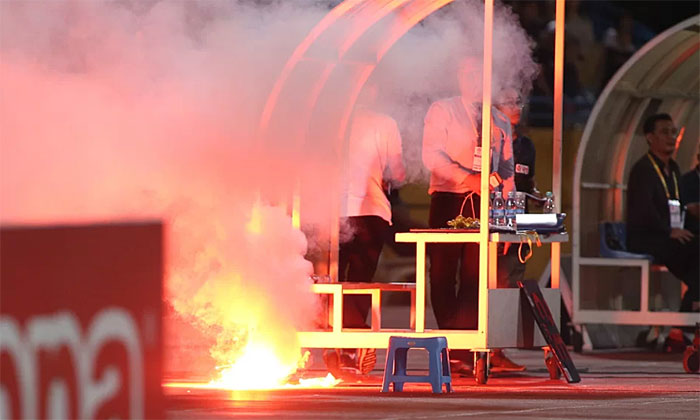How dangerous is flares?
Flares contain toxic chemicals that are harmful to the respiratory system when inhaled, burned, or poisoned, leaving a lasting consequence for the victim.
Dr. Khuat Quang Son, a lecturer at the University of Fire Prevention and Control, said the chemical composition of the flare consists of three components: strong oxidants (potassium nitrate, potassium chloride, potassium perchlorate .), flammables (fine coal powder, sulfur, asphalt paraffin .) and colorings. There are also additives such as calcium carbonate, vaselin, shellac colored powder. The temperature of flares is from 1,200 to 3,000 degrees Celsius, flammable and ignite, concentrated mass of 50 grams can cause explosion.
In Vietnam, the flares used by the fans are usually standard flares, the highest temperature reaches about 1,600 degrees Celsius, can burn for 60 seconds. Therefore, when lighting flares in crowded crowds, people nearby are susceptible to serious injuries in the face, eyes, chest, hands, neck .

Stadium flares are not easy to extinguish because they are designed to irritate water.
"In addition to health problems, lighting flares has many consequences such as fires, fires, even death for the people burning the firecrackers as well as those around them," the doctor said.
This type of cannon can burn clothing in a blink of an eye and cause burns to humans. Severe burns are very susceptible to poisoning (due to sulfur-containing flares) and leave many aesthetic sequelae such as bad scars, scissor scars, worse than affecting muscles, bones .
According to Dr. Son, the flare at the stadium is not easy to extinguish because it is designed to irritate the water. Without the timely intervention of the fire brigade, the cannon is difficult to extinguish, the risk of burns is very high. Even when the fire has stopped, the cannon is still too hot for us to touch.
In addition, plastic chairs in the stands also risk fire when exposed to flares and generate toxic substances such as carbonmono oxide, sulfur, mercury dust, strong oxidizing agents and metal dust. Smoke density reduces 20-50% of visibility.
Exposure time of chemical fumes under 3 minutes will slightly affect the body. Over 3 minutes, the respiratory system begins to be affected, especially for people with a history of respiratory disease, asthma. The toxins can cause capillary edema to block the airway.
The smoke of flares directly affects the eyes, causing tearing or corneal ulcers. Sulfur gas is a shock and strong respiratory sensitizer, immediate effect. Carbonmono oxide gas reduces plant nerve reactions and coma.
- Solar flares
- Eye protection
- 10 most dangerous animals on the planet
- Video: Dangerous germs hidden in Arctic ice are melting
- The most dangerous shark assassins in the ocean
- The sun is continuously
- In the plethora of deadly epidemics, what is the most dangerous virus in history?
- Dangerous behavior of adolescents
- 20 world's most dangerous creatures lethal in a split second (part 1)
- The US removed the ban on fundraising for research on
- Learn some dangerous blood diseases
- Young people often get caught up in dangerous games
 13 causes of non-itchy rash
13 causes of non-itchy rash How the mouse with human ears changed the world?
How the mouse with human ears changed the world? The truth about 'fried rice syndrome!
The truth about 'fried rice syndrome! What is dental implant?
What is dental implant?